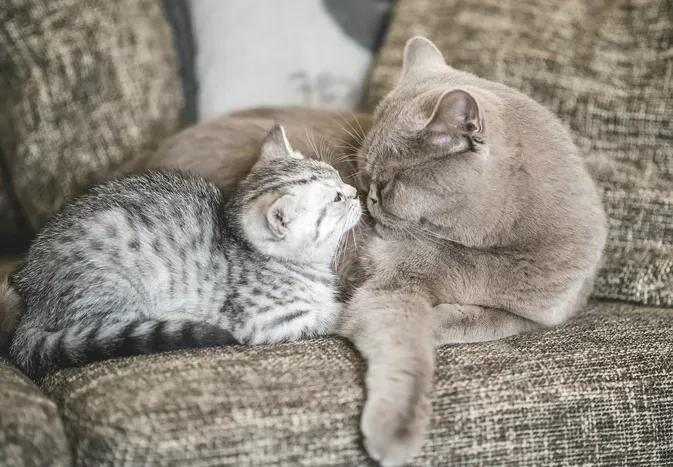How to Introduce a Kitten to an Older Cat
Updated on 04/26/24

Headline: A Tail of Two Kitties: A Step-by-Step Guide to Introducing a Kitten to an Older Cat
Introduction:
Inviting a new feline friend into your home can be an exciting yet daunting prospect, especially if you already have a resident kitty. Introducing a kitten to an older cat requires a strategic and compassionate approach to ensure a harmonious and stress-free transition for both parties. Here's a comprehensive guide to help you navigate this delicate process, fostering a loving bond between your furry family members:
1. Preparation: Setting the Stage for Success
Before welcoming the kitten into your home, it's crucial to prepare your older cat for the new arrival:
* Establish a Safe Haven: Create a cozy, private space for your older cat where they can retreat to if overwhelmed or stressed. Place their bed, litter box, and food and water bowls in this designated safe zone.
* Identify Potential Triggers: Observe your older cat's behavior and identify situations or objects that may evoke fear or aggression. This could include loud noises, sudden movements, or unfamiliar scents.
* Introduce Scent Gradually: Before the kitten arrives, exchange items that carry each cat's scent. Place a blanket or towel used by the kitten in your older cat's area and vice versa. This allows them to become familiar with each other's presence without direct contact.
2. Initial Introduction: A Slow and Supervised Approach
When the kitten arrives, keep them in a separate room initially. Allow your older cat to approach and investigate the kitten's scent under the door or through a baby gate.
Once your older cat shows signs of curiosity without overt aggression, gradually increase their interactions:
* Supervised Play Time: Introduce the kitten to your older cat for short periods of supervised play time. Use treats and praise to encourage positive interactions.
* Separate Feeding Areas: Feed the cats in separate locations to minimize potential competition or territorial disputes.
* Provide Vertical Space: Cats feel secure when they have access to elevated surfaces. Ensure there are plenty of cat trees or shelves where both cats can seek refuge if needed.
3. Gradual Integration: Building Trust and Affection
As your older cat becomes more comfortable with the kitten, gradually increase their unsupervised interactions:
* Controlled Exposure: Allow the cats to interact in neutral areas of your home, such as a hallway or living room, where they have plenty of space to move around.
* Positive Reinforcement: Reward both cats for calm and friendly behavior. Use treats, praise, or gentle petting to encourage positive interactions.
* Patience and Observation: Introducing a kitten to an older cat can take time and effort. Be patient and observant, monitoring their interactions closely to intervene if any signs of conflict arise.
4. Troubleshooting Common Challenges
Despite careful planning, it's possible to encounter some challenges during the introduction process. Here are some tips to address common issues:
* Aggression: If your older cat displays aggression towards the kitten, separate them immediately and seek professional guidance from a veterinarian or certified animal behaviorist.
* Fear or Avoidance: If your older cat is fearful or avoids the kitten, provide them with plenty of reassurance and support. Create a safe and calming environment and avoid pressuring them into interactions.
* Litter Box Issues: Introduce separate litter boxes for each cat, especially if your older cat is territorial. Place them in different locations to minimize conflict.
5. Ongoing Harmony: Fostering a Lasting Bond
Once your cats are comfortable with each other, continue to support their harmonious coexistence:
* Provide Enrichment: Offer plenty of engaging toys, scratching posts, and climbing structures to keep both cats stimulated and entertained.
* Monitor Interactions: Regularly observe your cats' interactions and address any changes in behavior promptly.
* Foster a Positive Relationship: Spend quality time with both cats, creating positive associations with each other. Consider joint play sessions, grooming, or cuddles.
Conclusion:
Introducing a kitten to an older cat can be a rewarding experience with the right preparation, patience, and support. By following these steps and addressing potential challenges along the way, you can foster a harmonious and loving bond between your furry family members. Remember that every cat is unique, so tailor your approach to their individual needs and personalities. With time, love, and a little bit of effort, you can create a peaceful and enriching environment for both your feline companions.
Explore More Pets

Cat Behavior Problems
How to Stop Aggression in Kittens

Long-Haired Cat Breeds
Siberian Cat: Breed Profile, Characteristics, & Care

Cat Behavior Problems
How to Stop Kittens From Scratching and Biting

Long-Haired Cat Breeds
Turkish Angora: Cat Breed Profile, Characteristics & Care

Basic Training
How to Socialize Your Kitten

Short-Haired Cat Breeds
Cute Pictures & Facts About Calico Cats & Kittens

Litter Box Training
Training Your Kitten to Use the Litter Box

Long-Haired Cat Breeds
10 Fun Facts About White Cats